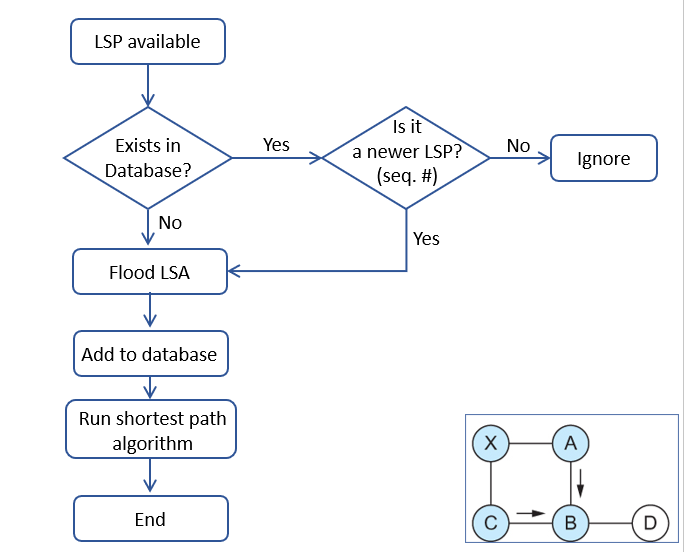Less likely to have loops than Distance Vector Routing (but loops still possible)
Strategy:
- Send to all nodes (not just neighbors) information about neighbors (not connection to all nodes)
- All nodes will know the link-state information of all other nodes
Link State Packet (LSP) contains:
- The ID of the node that created the LSP
- Costs of links to each directly connected neighbor
- A sequence number (SEQNO)
- Necessary because node would send out multiple packets, you need to know which one is the latest
- A Time-To-Live (TTL) for this packet
- To make sure old information is eventually removed from the network
- Also uses hop count (but doesn’t replace time-to-live, that’s crucial for deleting outdated information)
- Currently, IP uses 64 hops as default value (for what? hops? seconds?)
One link state routing protocol (implementation?) is Open Shortest Path First (OSPF)
Reliable flooding
Reliable flooding: Makes sure all nodes in the network get a copy of LSP from all other nodes
- After reliable flooding, each node has a snapshot of whole network
- Now each node can calculate shortest route itself
- Can use Dijkstra’s shortest path algorithm
Goals:
- Ensure all nodes get LSPs from all others
- Flood in minimum time
- Minimize total routing traffic
Algorithm
- Store most recent LSP from each node
- Knows which one is most recent based on sequence number
- If get two identical copies, accept the one that came first
- Forward LSP to all nodes except the one that sent it
- Generate new LSP periodically; increment SEQNO
- Start SEQNO at 0 when reboot
- Because can’t maintain state to pick up at the previous SEQNO
- Decrement TTL before flooding it to neighbors
- Also age the stored LSP (i.e., decrement TTL)
- Discard when TTL hits 0
LSP processing flow
- When you get a new LSP, flood before adding to database and processing
- This is because you want to make sure the other nodes get the LSP as soon as possible
- Processing takes time
- For shortest path routing, in practice, each switch computes its routing table directly from the LSPs it has collected using a realization of Dijkstra’s algorithm called the forward search algorithm
